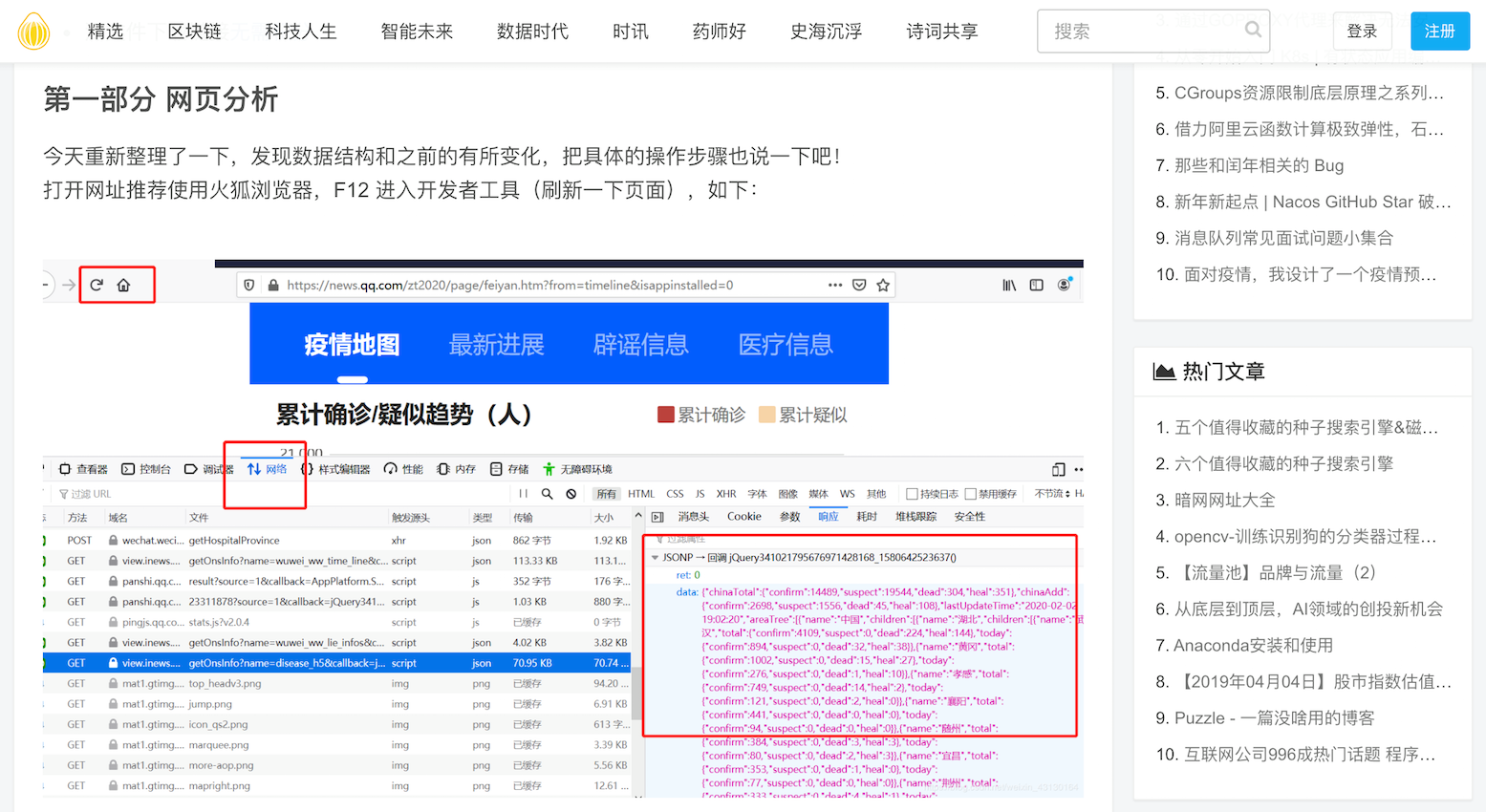by Brian Hioe and Lars Wooster
語言:
English /// 中文
Photo Credit: Screenshot
WITH TAIWAN and much of the world gravely concerned about the outbreak of COVID-19, the World Health Organization’s official name for the disease caused by the 2019 Novel Coronavirus (now SARS-CoV-2), the responsibility of news organizations and journalists to convey accurate information to the public is of greater importance than ever. It is, however, an unfortunate fact that some media outlets have abandoned this responsibility, turning to more sensationalist forms of reporting to manufacture controversy and boost readership. In the midst of a worsening epidemic, credulously publishing unsubstantiated rumors and misinformation poisons the well of public discourse, and performs a disservice to society.
Perhaps the most egregious example of this in domestic English-language media is Taiwan News, an online media platform owned by Luis Ko, the CEO of I-Mei Foods, a major Taiwanese brand. According to their “About Us” page, Taiwan News averages “more than two million visits monthly, 80% of which come from abroad”, and there is evidence its international reach has greatly increased in recent weeks after publishing a number of articles making extraordinary claims about the coronavirus outbreak in China. Two articles in particular deserve additional scrutiny; both were written by Keoni Everington, whose bylines list him as either “editor” or “staff writer”.
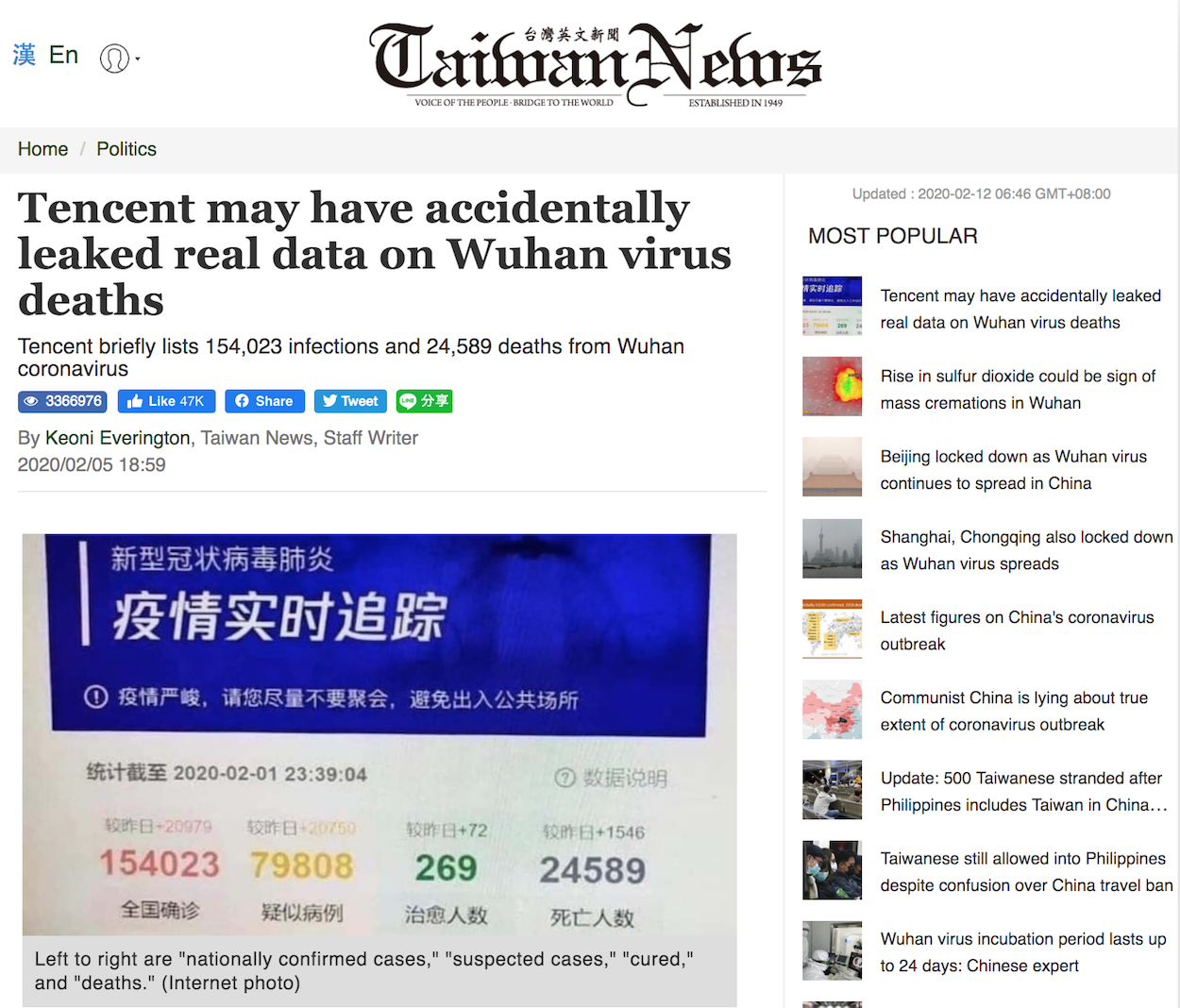 The article in question. Photo credit: Screenshot
The article in question. Photo credit: Screenshot
The first article, entitled “Tencent may have accidentally leaked real data on Wuhan virus deaths” and originally published on February 5th, claims: “As early as Jan. 26, netizens were reporting that [Chinese social media company] Tencent, on its webpage titled ‘Epidemic Situation Tracker,’ briefly showed data on the novel coronavirus (2019-nCoV) in China that was much higher than official estimates, before suddenly switching to lower numbers.”
The article cites screenshots posted to Facebook by a Taiwanese netizen, showing both Tencent and Chinese internet company NetEase reporting 15,701 infections and 2,577 deaths on the tracker, but then dropping back to the official count of 2,075 infections and 56 deaths hours later. Another set of images of the Tencent website is included, although these are photographs of a screen (rather than direct screenshots, presumably so they cannot be easily edited after capture), and their sourcing is unknown. These show 154,023 infections and 24,589 deaths on February 1st, later dropping to 14,466 infections and 304 deaths on February 2nd. Everington reports various explanations for these discrepancies, all of them highly speculative, and quickly moves on to discuss more uncertainties about official data coming out of China.
Everington’s article has been widely circulated online, racking up over 3.3 million hits and 47,000 Facebook likes according to the self-reported metrics displayed on the original article. It also earned more than 2,000 retweets on Twitter, an endorsement by far-right conspiracy theorist Paul Joseph Watson, and was even referenced by the notorious UK tabloid The Daily Mail, among others. However, one notes that the article is wholly reliant on unverifiable images, which easily could have been doctored, and claims of support by anonymous sources, who cannot be verified. Extraordinary claims require extraordinary evidence, and these uncorroborated reports and anecdotal claims are remarkably thin gruel for what would otherwise be a huge story. Indeed, we are left with only conspiratorial conjecture, rumors, and innuendo, the very last thing we should be injecting into the body politic in a time of crisis.
Video of Dr. Seheult of Medcram.com responding to the Taiwan News article. Film credit: Medcram.com
This Taiwan News article spread so widely that Medcram.com, a YouTube channel run by medical professionals with over 480,000 subscribers, was compelled to debunk its claims. They calculate a mortality rate of 16% from the second set of images included in the article and note that in COVID-19 cases outside of China—where the Chinese government logically cannot be obscuring information—the observed mortality rate was closer to 1% at the time of publication.
It is highly likely that the Chinese government is, in fact, concealing important metrics related to the spread of the epidemic. But, that being the case, we have even more reason to be skeptical as to why the social media network company Tencent (or NetEase, for that matter) would be granted access to accurate, real-time medical data from otherwise confidential government sources. This would introduce the risk of accidentally exposing this data to random members of the public (as the Taiwan News article claims occurred) or even an intentional leak to the media.
One of many Chinese websites demonstrating how to scrape data from the Tencent epidemic tracker to generate custom visualizations. Photo credit: Screenshot
A closer look at the Tencent epidemic tracker reveals a link to a public dataset that anyone can access. And indeed, hundreds of Chinese web developers have been scraping data from the Tencent website to generate their own custom visualizations over the last several weeks, saving snapshots of the main Tencent dataset at different times, and sharing them along with their source code. Searching all available datasets reveals none of the inflated figures appearing in the images promulgated by Taiwan News.
Everington also alleges that the higher figures reported in his article are “eerily” consistent with those of a study from University of Hong Kong researchers published in The Lancet on January 31st, 2020. This study attempts to estimate the real number of infections over the course of the outbreak and explores several different computer-modeled scenarios to forecast the epidemic. Everington latches on to two figures mentioned in the summary of the paper: an estimate of 75,815 infected cases in Wuhan on January 25th, and an epidemic doubling time of 6.4 days. Everington uses these figures to extrapolate approximately 150,000 infections in Wuhan on February 1st, similar to the count appearing in one of the images reported by Taiwan News.
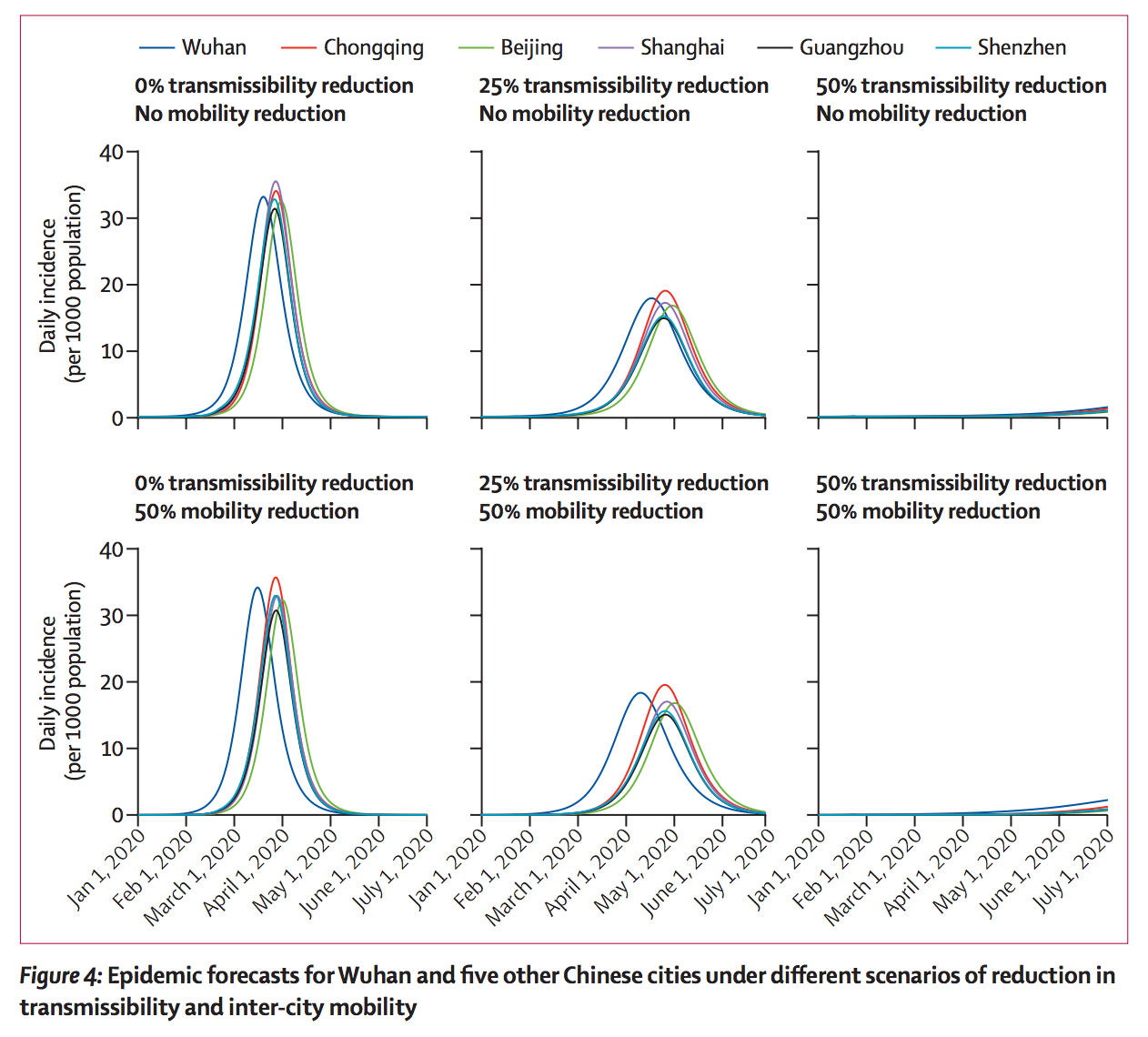 Modeling results from the University of Hong Kong study in The Lancet showing very different results based on reductions in transmissibility and inter-city mobility. Photo credit: Screenshot
Modeling results from the University of Hong Kong study in The Lancet showing very different results based on reductions in transmissibility and inter-city mobility. Photo credit: Screenshot
A closer look at the cited study reveals that these estimates are a product of the baseline scenario, in which there is no reduction of transmissibility or inter-city mobility. In other words, 150,000 infections around February 1st is close to what this study forecasts if no action whatsoever were taken to respond to the outbreak. This has not at all been the case, seeing as the city of Wuhan has been on lockdown since January 23rd. As Wuhan is a city with a population of 11 million people, this is the largest lockdown of its size in human history. Travel restrictions were then widened, affecting a total of 56 million people, and a number of countries have imposed travel restrictions on individuals from China, Macau, and Hong Kong, including Taiwan, the US, UK, Australia, Singapore, Vietnam, and others.
COVID-19 statistics are no doubt underreported, almost certainly because of the immense strain the outbreak is placing on the Chinese medical system and the lack of testing kits. It is also possible that the Chinese government is, in fact, attempting to downplay the size of the outbreak in order to maintain the appearance of having the situation under control in China. But the University of Hong Kong study in The Lancet is not evidence that Tencent mistakenly revealed real government data to the public. In fact, this study forecasts wildly different outcomes based on various public health interventions. Everington is cherry-picking data, highlighting an estimate derived from one scenario in one study to give those grainy Tencent images an undeserved aura of scientific legitimacy.
Where’s @niubi? Cat got your tongue?
— Keoni Everington (@keverington) February 8, 2020
Comments by Everington on Twitter responding to a Tweet by Bill Bishop questioning his article
In response to questioning of his article on Twitter by individuals such as noted China expert Bill Bishop, Taiwan News and Everington repeatedly asserted access to anonymous eyewitness accounts. This would not be the first time Taiwan News has made such claims to defend its reporting. On June 4th last year, the Ministry of Foreign Affairs issued a press release denouncing a report from Taiwan News which cited an anonymous source claiming the Tsai administration had denied both the Dalai Lama and Rebiya Kadeer visas to visit Taiwan. Most notably, the article in which Taiwan News reported this was written in Chinese and posted on the Chinese-language section of the website, but actually attempts to cite the English-language version of the same article as a source to justify its claims within it.
In a February 7th video appearance on WION, an Indian television channel with more than 400,000 subscribers on Youtube, Everington reiterates his belief that the Tencent images are real and newsworthy, stating: “If this is a hoax, it’s an incredibly sophisticated hoax based on scientific modeling. They have to be incredibly smart people to be, like, running a hoax like this. And actually be able to hijack the Tencent website, you know, hack into it, put in, like, scientifically based numbers, and then take it down and not get discovered and to hack it again, I mean that seems more farfetched to me…” In a second appearance on WION on February 9th, Everington continues to emphasize the importance of the numeric cherry-picking underpinning his reporting: “We don’t know anything. We don’t know what to believe. The only thing we do know about Chinese statistics is that they’re always fake. So that’s the only thing we know. It’s just uncanny, it’s eerie, it’s amazing that these numbers are matching exactly with the University of Hong Kong study, you know, with a very slight variation.”
Everington’s appearance on Indian television news channel WION about his report. Film credit: WION/YouTube
Everington appears ignorant of the technical ease with which these images can be produced; there is no need to “hijack” any website; just about any modern web browser allows even minimally competent users to edit source code on the fly, and a doctored image like those championed by Taiwan News can be made in an instant. One hardly needs to be a technical genius to plug big, scary numbers into Tencent’s epidemic tracker before taking a picture of one’s handiwork, and the fact that one of these numbers is somewhat close to a back-of-the-envelope calculation based on one of many scientific studies exploring various forecasts of the epidemic is not news. The simplest explanation is that the images appearing in the Taiwan News article were doctored, which is precisely what Tencent stridently claimed in a statement issued after the story went viral, and the numbers have no hidden meaning.
The second Taiwan News article by Everington, which is already approaching 400,000 views, proves far less difficult to debunk. According to Everington, “Data from Windy.com on Sunday (Feb. 9) showed heightened levels of sulfur dioxide around Wuhan, the epicenter of the novel coronavirus (2019-nCoV), causing some to speculate that it is a sign of mass cremations of victims of the deadly disease.” This article again features heavy sourcing from anonymous social media accounts, though they are embedded within the article this time—in this case, several Tweets from an anonymous Twitter account. The claim: heightened levels of sulfur dioxide in the Wuhan area result from incinerating large numbers of dead bodies, part of a cover-up to obscure the scale of the outbreak.
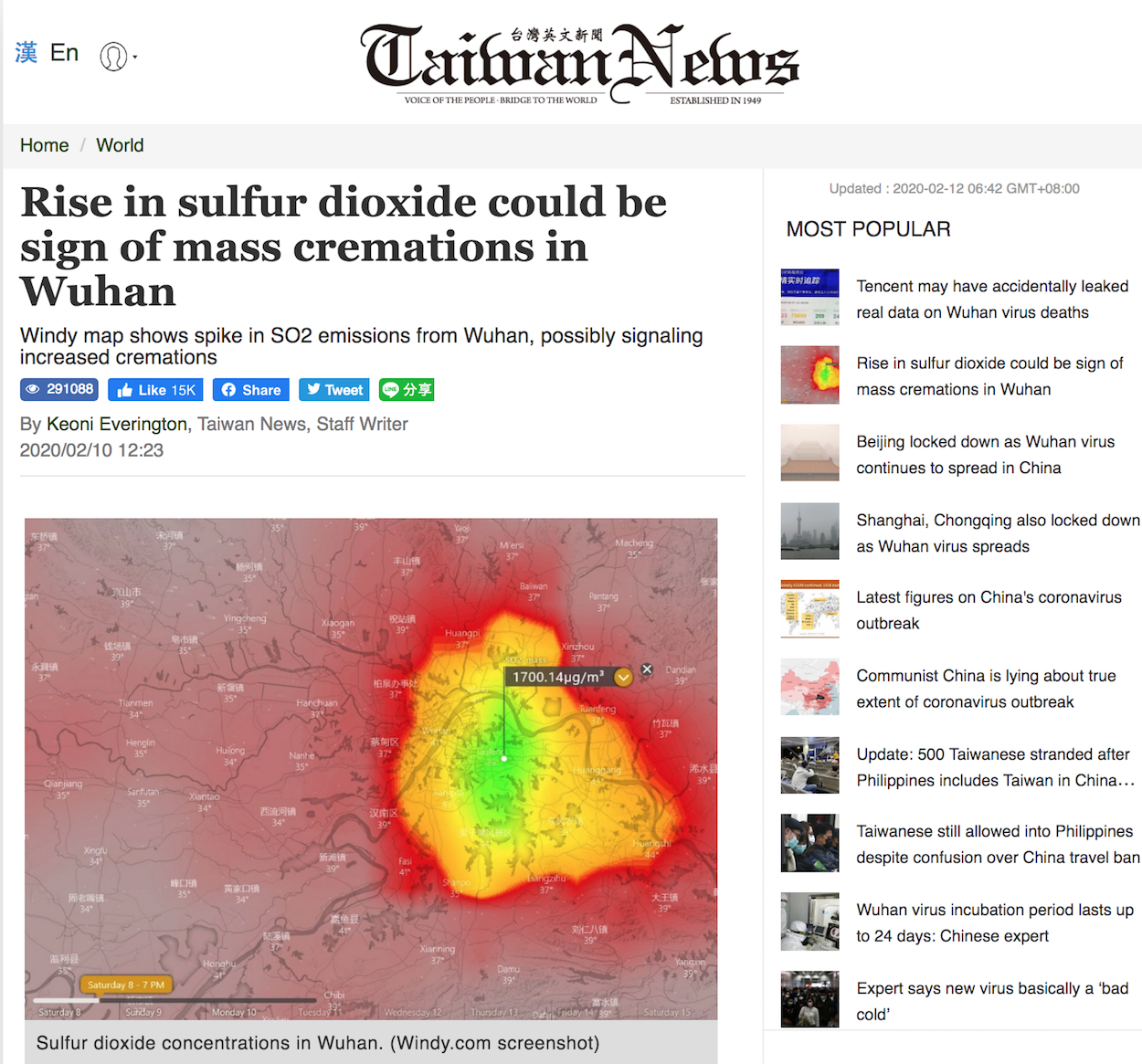 The article in question. Photo credit: Screenshot
The article in question. Photo credit: Screenshot
Windy.com, however, does not display real-time empirical data; it is a forecasting visualization tool reliant on projections from datasets like those of the NASA GEOS-5 model, a computer simulation of various elements of the earth system. Sulfur dioxide values seen on Windy.com are derived from this model, not current satellite measurements. Although historic trends are input into the underlying model, by definition it cannot predict individual events like a volcanic eruption (one of the primary sources of sulfur dioxide emissions) or, for that matter, mass cremations (even assuming the burning of bodies could generate emissions measurable by satellite, another avenue for skeptical inquiry). Thus, the very basis of this second Taiwan News article is demonstrably unsound, a product of Everington mistaking forecasted data for actual measurements of something taking place in the real world.
It is possible to look up current satellite data using tools such as the NASA Worldview website, which provides access to various sulfur dioxide datasets. Browsing through data reported over the last several weeks indicates nothing unusual in the vicinity of Wuhan. Why, then, would the data projected by Windy.com show such high concentrations of sulfur dioxide? Wuhan is home to some of the largest steel mills in China, including several of the China Baowu Steel Group, as well as coal power plants and other heavy industry associated with sulfur dioxide emissions. China’s ongoing struggles to reduce air pollution are already widely known, so it should come as no surprise that modeling might forecast alarming values in this highly industrialized area.
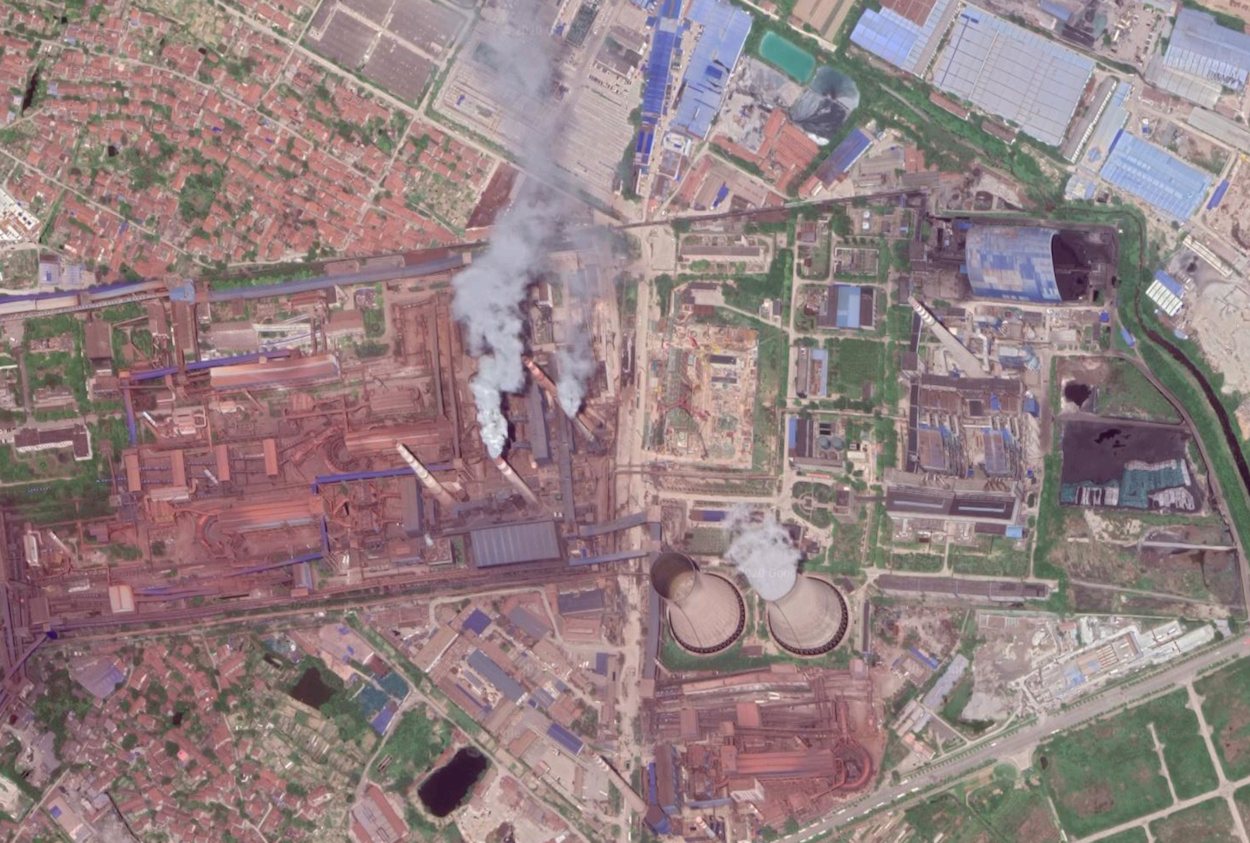 Satellite map of part of an immense, sprawling industrial complex on the outskirts of Wuhan. Photo credit: Google Maps
Satellite map of part of an immense, sprawling industrial complex on the outskirts of Wuhan. Photo credit: Google Maps
Social media is overwhelmed with fake news, propaganda, conspiracy theories, and other forms of misinformation. It is possible to report on what mostly anonymous “netizens” are discussing in a newsworthy and responsible manner, but both of these Taiwan News articles amplify potentially harmful falsehoods without performing even the most precursory fact-checking and due diligence. Everington cannot claim to merely be the messenger after making media appearances promoting his own spin on a grand conspiracy theory that the COVID-19 mortality rate is vastly higher than official sources state, and that China is engaged in a large-scale cover-up of tens of thousands of additional deaths.
Given the dangers of spreading misinformation during an epidemic, severe fines have already been imposed under the provisions of the Communicable Disease Control Act, which allows for penalties up to 3 million NTD. As reported by Taiwan News, a 29-year-old man surnamed You is now facing charges for spreading rumors that drinking cyanide could prevent COVID-19 infections. More recently, and also reported by Taiwan News, the Criminal Investigation Bureau announced the arrest of three individuals suspected of spreading rumors about a toilet paper shortage that led to widespread panic buying.
 The Taiwanese Ministry of Health and Welfare in Taipei. Photo credit: Solomon203/WikiCommons/CC
The Taiwanese Ministry of Health and Welfare in Taipei. Photo credit: Solomon203/WikiCommons/CC
Clearly the government is serious about combating fake news and misinformation related to the COVID-19 outbreak, but what about the sort of conspiracy-mongering Taiwan News is presently engaged in? With the government having taken action against users simply spreading rumors on social media networks on Facebook or Line in the form of individual posts, one imagines the government would be even more concerned about misinformation and falsehoods published by one of Taiwan’s largest English-language media outlets. It remains to be seen whether Taiwan News will face any meaningful consequences for its dubious reporting and casual disregard for journalistic standards, but the public certainly deserves better than this.
Brian Hioe (丘琦欣) is one of the founding editors of New Bloom. He was Democracy and Human Rights Service Fellow at the Taiwan Foundation for Democracy from 2017 to 2018.
Lars Wooster is a former biosciences graduate from Boston with an enduring interest in public health policy, skeptical inquiry, and craft beer. An irregular visitor to Taipei and environs, he is constantly on the hunt for the best beef noodle soup in town.


